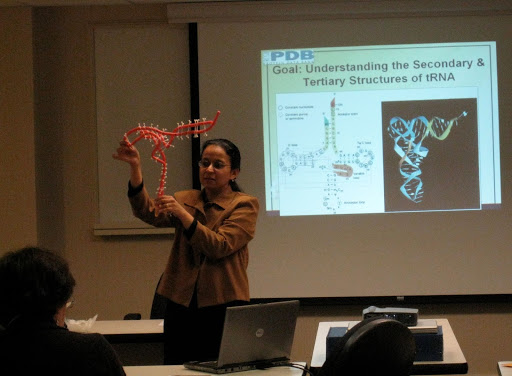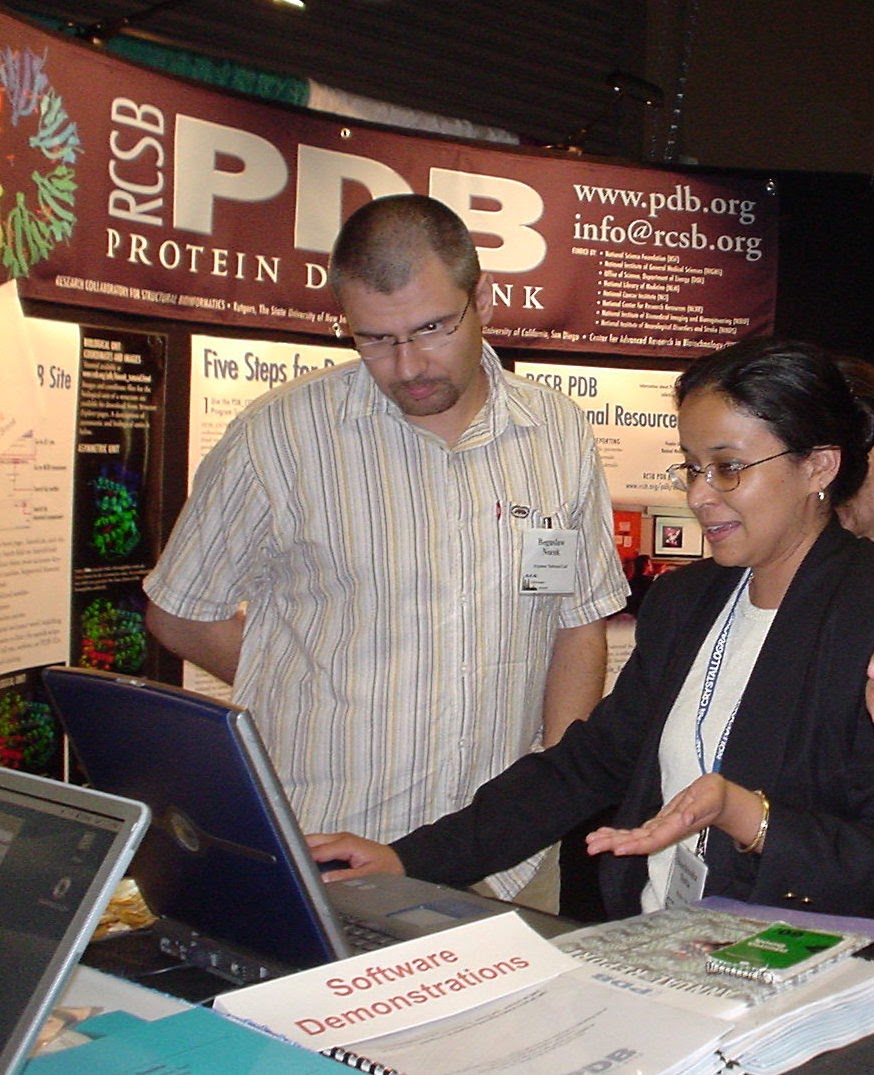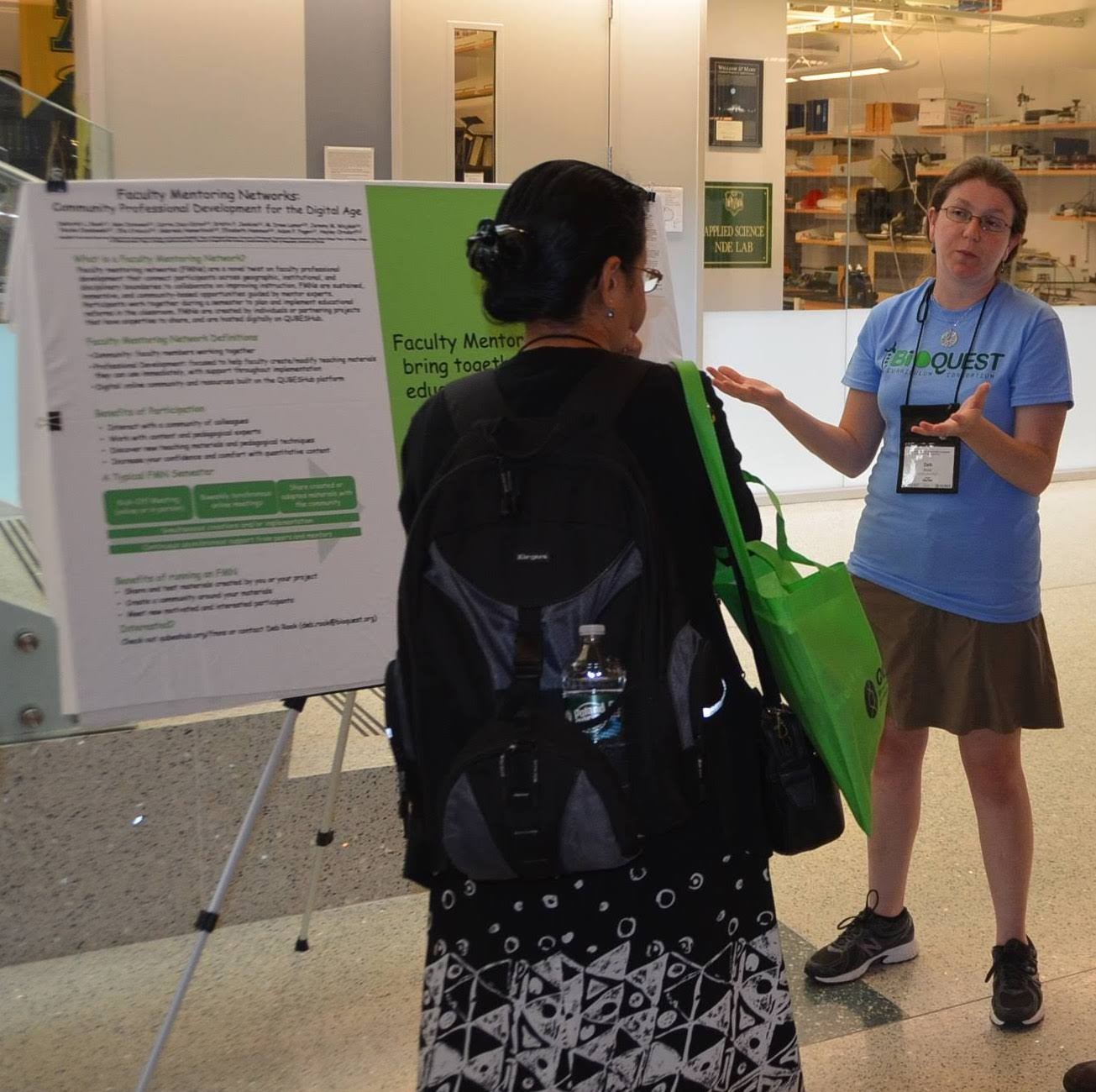Shuchismita Dutta, PhD, and Molecular CaseNet

This month we are featuring Shuchismita Dutta, PhD, a structural biologist and educator, and one of our FMN mentors. She is the Scientific Educational Development Lead for the RCSB Protein Data Bank (PDB), an Associate Research Professor at the Institute for Quantitative Biomedicine at Rutgers University, and member of the Cancer Pharmacology Program at Rutgers Cancer Institute of New Jersey. Her niche is promoting the visualization of biomolecular structures to learn about their shapes and interactions in order to understand their functions in biology and medicine. A strong supporter of interdisciplinary explorations, she is also interested in how students learn, think, and reason.
As the PI for Molecular CaseNet, an NSF RCN-UBE funded project, Shuchismita facilitates the development and use of case studies that offer ready-to-use stories for engaging students in exploring biomolecular structures, interactions, and their biological functions. In the past three years, she has collaborated with over 25 undergraduate educators to develop and pilot molecular case studies. She is currently working on developing a variety of educational materials that will support students and educators in using biomolecular structures in teaching and learning.
Shuchismita joined the BioQUEST and QUBES community at summer workshops (in 2017, 2019, and 2020) and has gone on to lead Faculty Mentoring Networks (including one this spring), and two parallel BIOME Institute working groups in Fall 2020.
(pictured above: Shuchismita making 3D models of tRNA with educators, NJ 2009.)
What made you interested in STEM education reform?
I am a biologist at heart. My undergraduate degree in Human Biology with a specialization in Biophysics, and masters in Biotechnology were both completed at All India Institute of Medical Sciences, a premier medical institution in India. It was during these formative years that I discovered my passion for molecular structures and was introduced to the idea of interdisciplinary and collaborative research and learning.
Molecular structures: Structures and interactions of biological molecules have fascinated me right from my undergraduate days. A paper model of an alpha helix that I made in a freshman year biochemistry class got me hooked, and I chose biomolecular structures as my lens to learn about and explore biology.
I began this journey using computational molecular modeling but decided to learn experimental structure determination using X-ray crystallography during my graduate training at Boston University School of Medicine. For my PhD, I solved the structure of a protein called nucleoplasmin, a chaperone involved in chromatin assembly. In my postdoctoral research, at Harvard Medical School, I focused on solving the structure of the T7 DNA polymerase bound to chemically modified nucleic acids.
I strengthened my connection with biomolecular structures when I joined the Protein Data Bank (PDB) as a biocurator. Here I got the opportunity to see pre-published structures and interacted with scientists submitting them. Beyond biocuration, I have contributed to improving data standards, developing tools and resources to better serve the needs of PDB users.
Collaboration: The lab that I joined for my graduate training was an electron microscopy lab! I was the first student in the lab doing X-ray crystallography and had to procure access to all instruments, set up computers with relevant software tools, and learn how to use them to perform my experiments. Since no one in the lab could teach me how to do all this, I had to quickly learn to figure things out on my own, by trial and error or by asking for help from experts in neighboring labs, other departments, and sometimes even other institutions! The confidence that I gained in taking charge of my learning continues to inspire me to take on new challenges, seek collaborators, and find my own path in things that I do today.

Teaching: For me teaching has been a very rewarding activity. I was a teaching assistant in graduate school, taught a course when I was a postdoc, and also volunteered at the Boston Science Museum to practice science communication. At the PDB, I was naturally drawn to education and outreach projects. I have created courses, educational resources, curricular materials, and professional development opportunities to promote a molecular view of biology.
Today I am fully engaged in various education-related activities - teaching students at various levels (high school, undergraduate, and graduate level) and actively collaborating with educators to help them develop lessons and case studies. Through these interactions I have learned about two critical components of STEM education: (a) training educators, and (b) creating collaborative networks for educators to learn/share experiences and ideas.
(pictured above: Shuchismita introducing scientists to new tools for exploring PDB structures, 2004)
What change are you working towards in STEM education, and how do you go about enacting that change?
My personal observation is that students and educators are more engaged when they are discussing a topic that interests them. A suitable hook can inspire students to dig deeper to identify key molecular players involved in the process/function of interest. Visualizing their molecular structure(s) can help examine their specific chemical interactions and how they facilitate biological function(s). These structure-function explorations address many of the core competencies mentioned in Vision and Change (2011) - e.g., understanding the process of science, use of quantitative and visual reasoning, modeling, integrating interdisciplinary information, collaborating, and communicating about a topic of interest (that is relevant to society).
Tell us about Molecular CaseNet.
The goals of Molecular CaseNet include:
-
developing molecular case studies at the interface of biology and chemistry;
-
developing and/or identifying resources to help students and educators use molecular structural and related bioinformatics data for teaching and learning; and
-
developing a network of educators who are enthusiastic about collaboratively developing and using these resources and case studies in their classrooms.
This project was inspired by an undergraduate seminar course that I have been teaching since 2006. In this course, students learn some foundational concepts in structural biology, and about the use of data from the PDB and related bioinformatics resources. Students are introduced to the course theme (e.g., a specific global health topic) by experts in the field, such as researchers and/or clinicians. Through the course students learn to explore and discuss the disease process and/or its treatment options in molecular detail.

A high level of student engagement in these courses and feedback from other educators inspired us to develop shorter versions of these theme-based explorations - the molecular case studies. The case study topic/story helps engage student interest, and the organization of the case guides students through interdisciplinary explorations, including examining chemical interactions and relating it to biological functions.
Discussions that originated at the BioQUEST/QUBES summer workshops and institute, and Faculty Mentoring Networks (FMNs) have led to the creation and publication of ~8 molecular case studies since the creation of Molecular CaseNet in 2018. The casenet has been mentioned/discussed in a few peer-reviewed publications and has been presented at various conferences and workshops in the past couple of years.
In July 2021, Molecular CaseNet is hosting its first summer professional development workshop for undergraduate educators. During the workshop participants will learn about various molecular visualization and bioinformatics tools and develop outlines for specific molecular case studies on their favorite topics. These case studies will be completed by the participants before the end of the calendar year, in preparation for piloting them with their students in the following spring.
What keeps you motivated and gives you hope?
My vision is that someday most educators and students will feel comfortable exploring molecular shapes and interactions while integrating information from various bioinformatics resources to ask new questions, interpret experimental results, and design molecules or systems with new properties and functions.
I am amazed at how some of these educators creatively introduce concepts and skills in their classrooms. When I see educators getting excited about using molecular case studies in their classrooms, I am inspired to continue working on this project.
I am also inspired by educators’ conversations regarding their challenges in using the data, tools, and resources offered by the PDB and other bioinformatics resources. The efforts of committed educators, who are willing to try new teaching approaches, share their ideas and experiences, and brainstorm to find solutions to address challenges they encounter gives me hope for realizing my vision.
How has QUBES and/or BioQUEST helped?
Connection to people: I have found the BioQUEST/QUBES community to be open-minded and collaborative in nature. Several educators that I met in the summer workshops and/or FMNs have contributed to developing molecular case studies and also piloted them in their classrooms. I am grateful to be a part of this community.
The BioQUEST/QUBES platform: The setup for open education resources in the BioQUEST/QUBES platform provides a convenient option for publishing the molecular case studies developed for Molecular CaseNet. In addition, the various adaptations developed by the FMN participants are also published here to showcase how the case studies may be used in various courses and curricular contexts.

Faculty Mentoring Network (FMN): During the summer workshop in 2019, I stopped by a poster presentation by Deb Rook about the Faculty Mentoring Network. At her suggestion, I decided to mentor a group of educators as they piloted the first draft of the molecular case studies. During this FMN (Spring 2020), the world shutdown in response to the COVID-19 pandemic. However, the participating faculty came up with creative ways to use molecular case studies to meaningfully engage students in learning biology/biochemistry as well as develop several valuable skills like reading the scientific literature and exploring and integrating data from various bioinformatics data resources. The FMNs have now become an integral part of developing and piloting molecular case studies for the Molecular CaseNet.
(pictured above: Deb Rook presenting the FMN to Shuchismita at College of William and Mary, Williamsburg, VA, 2019)
Why is the mentoring model important?
Mentors help and guide you, connect you with the right people, opportunities, and resources, and most importantly believe in you and support you in accomplishing your career goals. I have had many mentors who have and continue to influence/guide me in my professional career.
My graduate and postdoctoral advisors helped me build a strong foundation in structural biology while giving me the chance to learn to practice collaborative science. When I joined the PDB I learned and continue to learn from the former director Dr. Helen Berman and current director Dr. Stephen Burley. They both have encouraged and supported me as I search my niche in structural biology education.
Within the QUBES community, Dr. Pat Marsteller has been instrumental in introducing me to people and resources within the BioQUEST/QUBES network and outside. The participating faculty in the Spring 2020 and 2021 FMNs have also taught me a great deal about the needs and opportunities that molecular case studies can address.
Are there resources you’d like to point our community to?
The Molecular CaseNet is founded on the use of data, tools, and resources available from the PDB. I would like to draw your attention to the various educational materials, lessons and activities available from the educational portal, called PDB-101. Materials presented in this portal (e.g., tutorials, hands-on exercises, curricular materials, and videos) are designed for students, educators, and non-experts.
How can our community connect with you or get involved with your projects?
The published molecular case studies and a variety of resources for molecular visualization and exploration are available from Molecular CaseNet and from BioQUEST/QUBES. If you have any questions or comments about the Molecular CaseNet or are interested in participating in future summer workshops and/or faculty mentoring network discussions, please write to me at sdutta@rcsb.rutgers.edu.